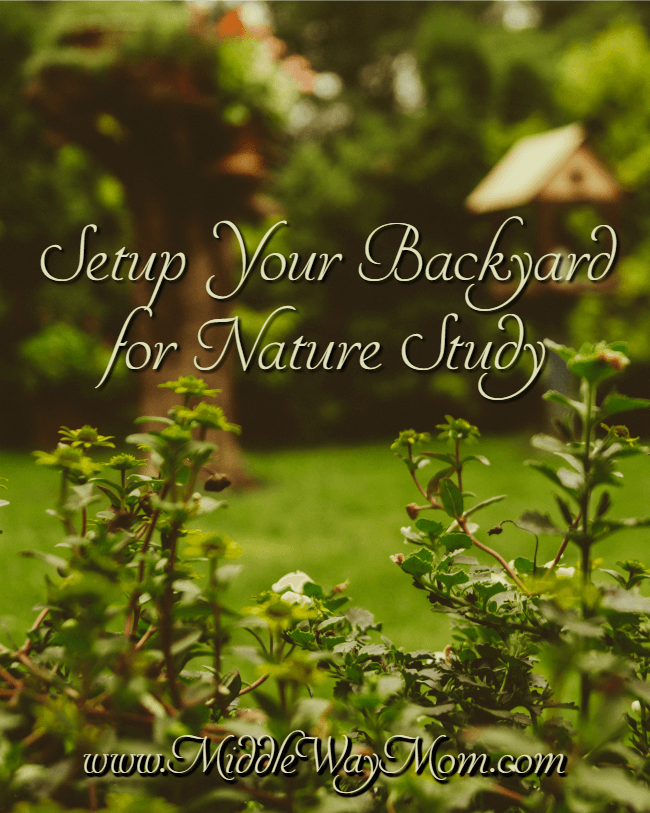I have big plans, guys. We’re going to spend hours outside each week, rain or shine. I’m going to let my kids run in the puddles and jump in the snow.
But then I remember: when my littles fall, they don’t get themselves back up. Our last outdoor adventure basically consisted of me picking my two youngest out of whatever branch tangle they got themselves into, and convincing them to walk rather than carry both of them in their mud-covered glory.
But I want my Kindergartener to really start on the road of nature study, even if her little sisters are more in the nature exploration phase. She’s an eager student, but while juggling the constant needs of small children, I’m not always an eager, or even available, teacher.
So, instead solely relying on heading out to nature reserves, I am bringing nature to us.
So, what are we using in our own yard to learn about the world around us?

Bird feeders
This can go in the “duh” category, but I wanted to mention something beyond the obvious: birds eat wasps. We have a wasp problem in our yard, probably exacerbated by the fact that many of our neighbors spray for this sort of thing, so they love our all-natural yard.
They lived under the siding for a few years, and since we got that replaced, I’ve now found two new nests in our yard. They need to go.
So, bring in more birds, a natural predator for wasps, and in sha Allah the wasp problem will start to work itself out. We’ll have other measures in place as well, but putting up a bird feeder is the most enjoyable, and it teaches the kids about the food web.
I can even have my kids look up which types of birds are most likely to eat wasps and get food that is most likely to attract those types of birds.
Oh, and lesson learned from last year: don’t use a shepherd hook off your deck railing to hang a bird feeder. You’re just feeding the squirrels.
Butterfly garden
Butterfly gardens (or pollinator gardens) are simply planting flowers that butterflies and bumble bees are attracted to. In addition, you can add a butterfly house to shelter butterflies in inclement weather. You can also buy carpenter bee houses (I saw these at Target this year), but we’ll be skipping that for now. At least until the wasps are under control, I don’t want more stinging insects making my yard a home.
For nature study, both the flowers and what they attract are worth noticing and observing. A fun activity would be to note how many different kinds of butterflies you notice in your garden, and if they tend toward certain types of flowers.
Pest control
Two pests we’ve been managing the whole time we’ve been at our house: Japanese beetles, and slugs (besides the wasps). They eat up our rose bushes and hostas like nobody’s business.
Another lesson on the food web, habitats for various bugs, and determining what is a pest and what isn’t. For so long we’ve treated bees as a pest, and now we see the after effect of that. Is there something useful that slugs do?
And what happens if you don’t control the pest population?
All very good learning tools, if we allow our children to be involved.
Gardens
Last year we had a container garden, and this year we are starting a perennial garden, in sha Allah, with strawberries and blueberries.
Kids LOVE to be involved with gardening, and there is so much to learn! For instance, I just learned that blueberry bushes should be planted along with other varieties of blueberries so they can cross pollinate. And now, in sha Allah, if these bushes are successful, my kids will remember that also.
There’s the obvious of watching seeds germinate and sprout, but make sure you’re not the only one with your hands in the dirt!
Let your kids help plant the seeds, and take care of them. Talk about what you’re growing, and why. Pass on this knowledge to your kids, or learn together (that’s what we’re doing!).
Indoor plants
Even on days where even getting out in the yard is not happening, or during the deep freeze of the winter when things don’t change very often, indoor plants teach kids a whole host of things.
A few that we really enjoy are our aloe vera plant, venus fly trap (super cool! And this particular Amazon seller is fantastic at supporting people who buy from him.), indoor herbs, and green onions that we replant from store bought ones.
Plus indoor plants can be great for cleaning the air inside. Another lesson to learn: air pollution and its sources.
Tree tapping
This isn’t for all places or all year round, but if you have a maple tree, don’t miss the opportunity to tap your maple tree! Seriously, this has been one of the most rewarding things in our yard so far.
You don’t have to fight back weeds, and it’s really hard to do it wrong. Keep your equipment clean, and follow the instructions. That’s it!
I use the sap to make tea and coffee, and boil down a large portion of it for making syrup. The kids love to cook with the sap, especially to make waffles or pancakes using sap within the recipe as well.
Once your kids are familiar with their own maple tree, they can try to identify other maple trees in the area, using their observation skills. And even beyond that, they can learn to identify other types of maple trees. For instance, we have a silver maple, but a friend has a sugar maple. What’s the same and what’s different?





Your backyard nature study sounds fantastic. We no longer have a backyard, but I am still looking forward to getting outdoors more with my daughters.